Free Continuing Education for Dental Billing Assistants
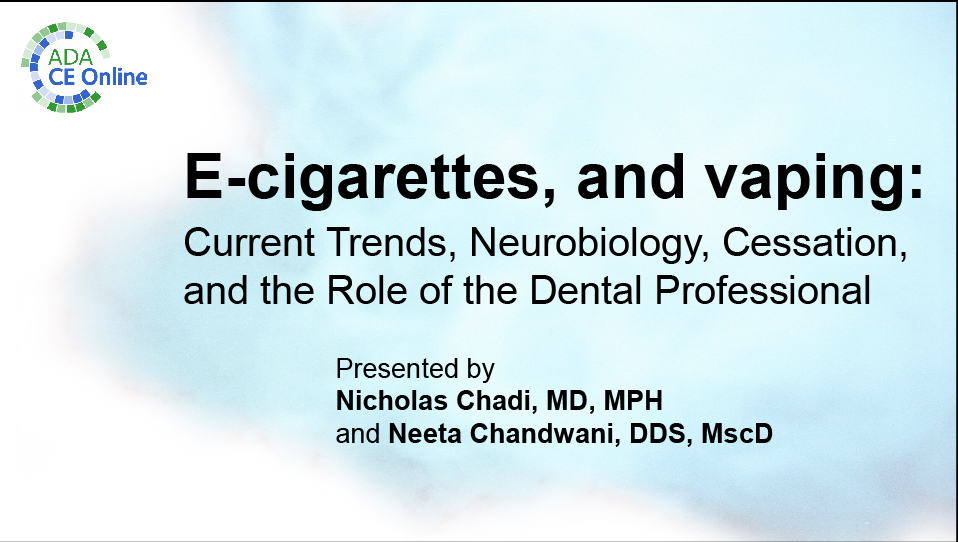
E-cigarettes, and Vaping: Current Trends, Neurobiology, Cessation, and the Role of the Dental Professional
Overview
While electronic nicotine delivery systems (ENDS) such as e-cigarettes were initially marketed as a harm reduction and smoking cessation strategy, there is conflicting evidence regarding their effectiveness as a smoking cessation strategy.
Given increasing rates of use of ENDS, especially among youth, and emerging concerns about potential ENDS-related harm, dental providers are strategically positioned to support population-level tobacco reduction efforts and provide health information about ENDS.
There is a pressing need for continuing education opportunities to help dental providers improve ENDS-related knowledge and counseling practices.
Presenters
Nicholas Chadi, MD, MPH: Clinical Assistant Professor at the University of Montreal, and clinician-scientist at Sainte-Justine University Hospital Centre in Montreal
Neeta Chandwani, DDS, MscD: Pediatric dentist at Boston Children's Hospital and the Predoctoral Program Director of Pediatric Dentistry at the Harvard School of Dental Medicine
Learning Objectives
Upon completion of this course, the dental professional should be able to:
• Understand the origin and development of electronic nicotine delivery systems (ENDS) such as "e-cigarettes" and "Puff Bars"
• Understand the mechanism of action and combustion science of ENDS
• Discuss the epidemiology and trends associated with youth vaping, including use of flavored, nicotine and cannabis vaping products
• Describe the neurobiology of nicotine and cannabis and the unique vulnerability of the developing adolescent brain
• Use evidence-based screening and brief intervention strategy to help prevent and reduce youth vaping
• Apply effective pharmacological and non-pharmacological cessation approaches for youth with an addiction to e-cigarettes and other vaping products
• Understand the current knowledge about the effects of ENDS on oral health
• Recognize the dental professional's role in appropriate education and recommendations
Disclaimer
The views of the presenter(s) do not necessarily represent the views of the American Dental Association.
This course is $49 for ADA members and $69 for non-members
Non-dentists and non-members are welcome to take this course. You'll be asked for an ADA Login when registering. Creating an account is free and does not require membership. Follow the links below to create an account.
Non-dentists
Non-dentists can create accounts here .
Non-members
Most U.S. dentists and dental students, regardless of membership status, have an ADA number, which functions as your User ID. To retrieve your ID, please visit Forgot User ID .
360CE
View Course
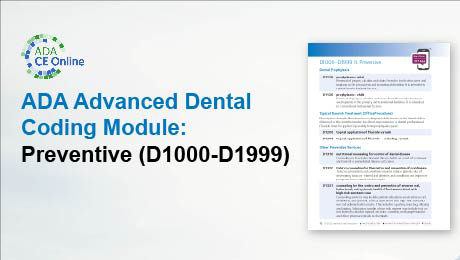
ADA Advanced Dental Coding Module: Preventive (D1000-D1999)
Expand on your coding expertise by diving deeper into CDT Code definitions and key concepts in Preventive category of service. Using coding scenarios based on real life situations, you will expand your knowledge on how to accurately document procedures completed and provide for the efficient processing of dental claims.
Since this is an advanced course, it is highly recommended that learners first complete the ADA Dental Coding Certificate: Assessment-Based CDT Program:
ADA Dental Coding Certificate: Assessment-Based CDT Program (books not included)
ADA Dental Coding Certificate: Assessment-Based CDT Program (books included)
NOTE: This course does NOT include the CDT 2022 or Coding Companion books. These books are required reference material necessary for succesful completion of the course. Designed for the Dental Team Note to CE Online subscribers: The ADA Dental Coding Certificate program is a premium course and not included in your subscription. 360CE DT_CE
As the source of dental procedure codes, the ADA has answered thousands of members' coding questions over the years. Based on this experience, the ADA created this training course to ensure your dental team understands CDT codes and how to use them correctly.
View Course
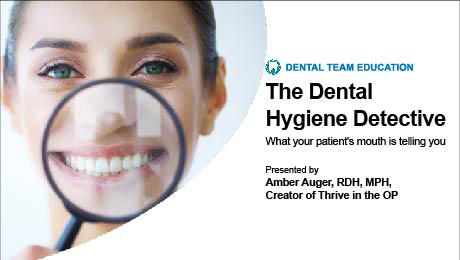
The Dental Hygiene Detective: What your patient's mouth is telling you (Dental Team Education)
There are many clues that provide evidence of diseases, such as occlusal wear, recession, bleeding, fissured tongues, erythemic tissues, incipient lesions, and many more. Determining our patient's high-risk factors for oral disease and systemic health is multi-factorial and our role as dental professionals allows us to evaluate the first signs of disease. This Dental Team Education course will help you and your team review the patient's risk factors in-depth, while empowering the clinician to compare clinical technologies that align with the patient's lifestyle to reduce decrease disease.
Presenter: Amber Auger, RDH, MPH
After this course you should be able to:
• Discover common oral conditions and identify what can be recommended for treatment
• Review clinical assessments to be used chairside that determine the severity of disease
• Evaluate the collaborative approach for prior disease management
DT_CE
View Course

ADA Advanced Dental Coding Module: Diagnostic (D0100-0999)
Expand on your coding expertise by diving deeper into CDT Code definitions and key concepts in Diagnostic category of service. Using coding scenarios based on real life situations, you will expand your knowledge on how to accurately document procedures completed and provide for the efficient processing of dental claims.
Since this is an advanced course, it is highly recommended that learners first complete the ADA Dental Coding Certificate: Assessment-Based CDT Program:
ADA Dental Coding Certificate: Assessment-Based CDT Program (books not included)
ADA Dental Coding Certificate: Assessment-Based CDT Program (books included)
NOTE: This course does NOT include the CDT 2022 or Coding Companion books. These books are required reference material necessary for succesful completion of the course. Designed for the Dental Team Note to CE Online subscribers: The ADA Dental Coding Certificate program is a premium course and not included in your subscription. 360CE DT_CE
As the source of dental procedure codes, the ADA has answered thousands of members' coding questions over the years. Based on this experience, the ADA created this training course to ensure your dental team understands CDT codes and how to use them correctly.
View Course
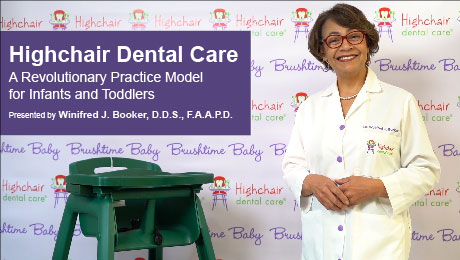
Highchair Dental Care: A Revolutionary Practice Model for Infants and Toddlers
Highchair Dental Care is an age-appropriate oral health care model — developed by Winifred J. Booker, D.D.S., F.A.A.P.D. — that identifies the opportunity to promote healthy behaviors at the point of care.
The purpose of the course is to share this revolutionary practice model with oral health professionals to:
• Help encourage more of these dental care providers to endear the 1 year-old patient
• Empower these dentists and dental hygienists with the most applicable and useful resources to do so
Dr. Booker shows you how this unique practice of dentistry is designed to excite more parents to decisively identify a dental home for their new baby before or by age 1. Highchair Dental Care provides an optimistic and insightful approach to infant oral health care. It teaches dental professionals an alternative way to treat children beginning as early as 8 months, while at the same time educating parents and caregivers. At this age babies can sit well for several minutes without support. The highchair provides the safety and security needed to conduct the proper infant oral exam. It also allows the infant this first examination in an environment familiar to them, which a traditional dental chair cannot.
Strategies that engage a child's natural inclination to open their mouth, to laugh or to eat is a part of the course instruction. By placing the baby in a highchair, they are comfortable and usually most willing to open-wide for their first oral examination and dental cleaning. It is a child-friendly approach to patient care that works well with most infants.
The Highchair Dental Care Practice Model offers an alternative standard to address infant oral health. This Practice Model draws attention to the importance of innovation and early interventions to prevent early childhood caries and other potential unfavorable sequelae.
NCDHM22
View Course

Choosing the Business Structure That's Best for Your Dental Practice (A Dentist's Guide to the Law Series)
Overview
So you want to start your own practice? One of the most critical threshold issues you'll face is which business structure to use. This decision will impact every aspect of your business (even day-to-day management decisions!) and will have tremendous legal and tax consequences. In this presentation – which supplements the American Dental Association's publication, A Dentist's Guide to the Law: 246 Things Every Dentist Should Know – ADA Associate General Counsel Samara Schwartz will orient you to the following:
• The 5 business formats utilized by virtually all dentist practices, and their respective pros/cons
• How to identify when to revisit your choice of legal entity, even after your practice is up and running
• The value of consulting with professional advisors (attorneys and accountants) to get actionable advice tailored to the state where you are practicing as well as your unique circumstances
This course is $49 for ADA members and $69 for non-members
Non-dentists and non-members are welcome to take this course. You'll be asked for an ADA Login when registering. Creating an account is free and does not require membership. Follow the links below to create an account.
Non-dentists
Non-dentists can create accounts here .
Non-members
Most U.S. dentists and dental students, regardless of membership status, have an ADA number, which functions as your User ID. To retrieve your ID, please visit Forgot User ID .
SEPAD21
View Course
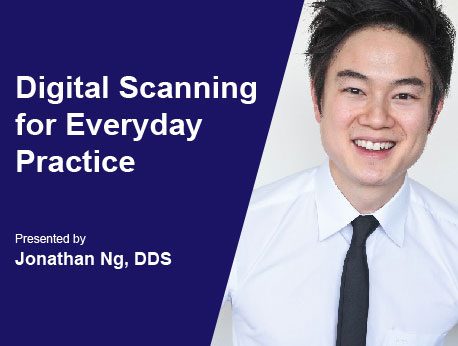
Digital Scanning for Everyday Practice
This course originally presented at the ADA SmileCon Virtual 2021.
Overview
The dental impression is used in almost every corner of dentistry and is the crucial first step. It must be accurate and effective. The use of digital technology not only makes what we do more efficient, but it makes us better. See how digital dentistry is essential to the modern practice and evaluate existing and new tools that will make you be at your best. See the benefits of better communication with labs, patients and between clinicians. Dramatically improve the way you practice dentistry.
This course covers:
• Compare and contrast conventional impressions and digital impression
• Advantages and disadvantages of technology and where it is used
• What is digital workflow and how it improves clinical practice
Presenter: Jonathan Ng, DDS, prosthodontist, BC Cancer Agency
View Course
Source: https://ebusiness.ada.org/education/default.aspx
Postar um comentário for "Free Continuing Education for Dental Billing Assistants"